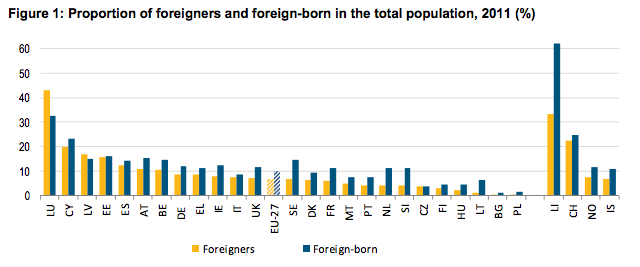2011 Census: the devil is in the detail
Today the headlines were by and large dominated by a new batch of figures from the 2011 Census. A number of interesting developments have emerged from the new release: the drop in the number of home owners, married couples, believers and Jedi knights, and of course the growth of the migrant population.
However, with the publication of so many figures and statistics, it is hardly surprising that the release generated a few instances of inaccurate reporting. Full Fact will try to set the record straight on some of the most flagrant errors.
"The population of Poles in England and Wales has grown ninefold over the decade." The Express, December 12, 2012
The paper goes on to say: "In 2001, Poland did not even feature in the top 10 countries of people born outside the UK. In 2011, it was second with more than 500,000 people (a rise of 89 per cent) from Poland now living in England and Wales."
Join 72,953 people who trust us to check the facts
Sign up to get weekly updates on politics, immigration, health and more.
Subscribe to weekly email newsletters from Full Fact for updates on politics, immigration, health and more. Our fact checks are free to read but not to produce, so you will also get occasional emails about fundraising and other ways you can help. You can unsubscribe at any time. For more information about how we use your data see our Privacy Policy.
So which one is it? Has the Polish population grown ninefold (+800%) or by 89 per cent? The ONS has in fact estimated that the number of residents in England and Wales who were born in Poland rose by six percentage points from one per cent (58,000) in 2001 to seven per cent (579,000) in 2011: a tenfold increase.
"The Office for National Statistics said the biggest increase in immigration was among people from Nigeria, who almost doubled their numbers to 191,000." The Telegraph
The growth of the Nigerian population is actually the second largest percentage increase in the top ten for foreign-born residents, an increase from 87,000 (0.2 per cent of the resident population) in 2001 to 191,000 (0.3 per cent) in 2011. The largest percentage increase was, as we have seen, that of the Polish population.
"The total population of England and Wales was 56.1 million, a seven per cent increase on 2001 — and 55 per cent of the increase was due to migration." The Express
This is accurate but there is a caveat. Between 2001 and 2011, the population of England and Wales rose by 4 million, of whom 2.9 million were born outside the UK. So over the last decade 71 per cent of the population increase was the result of growth in the non-UK born population. The 2011 Census first release of 16 July 2012 noted that 56 per cent of the population increase between 2001 and 2011 was due to migration. However, this is net migration of both UK born and non-UK born.
"Brits now make up 80% of the population and are in the minority in London for the first time" The Daily Star
Not quite. 80 per cent of the population of England and Wales describes itself as white British. Brits actually make up 87 per cent of the population and the remaining 13 per cent is foreign-born.
"The capital [London] is a melting-pot city, much as New York was a century ago. It is now more ethnically diverse than any in the world." The Telegraph
37 per cent of London residents are born outside the UK, whilst 24 per cent are non-UK nationals. One way to assess the cultural diversity of a city is to look at the percentage of its foreign-born residents.Though it is unclear whether the Telegraph is saying that London is the most ethnically diverse city or capital in the world, in a ranking of large metropolises, Dubai and Miami actually have a higher percentage of foreign born citizens: respectively 83 (Source: UAE Ministry of Labour) and 58.4 per cent (Source: US Census). However, in the case of Dubai that number is skewed on the high end, on account of the great influx of labourers from India and Pakistan.
"The highest number of people with foreign passports is in Kensington and Chelsea [...] where 43 per cent of residents are abroad. In Westminster [...] 40 per cent of the local population have foreign passports. In Newham [...] 34 per cent of the local population has a foreign passport." The Telegraph
The Telegraph is here quoting "separate Census figures," but it's unclear which ones they're referring to. Here is what the 2011 Census unearthed:

Brent is the London area with the greatest percentage of foreign residents (55.1%); Newham, Westminster and Kensington and Chelsea follow on with 53.7%, 53.3% and 51.6% respectively.
"England and Wales are ranked ninth among EU countries for the proportion of residents who are foreign-born, above Germany and France but below Spain and Sweden with Luxembourg top on 33 per cent." The Telegraph
It's unclear what the source for this claim is, but we can only assume the Telegraph has updated Eurostat data with the new Census figures. In 2011, the UK (including Scotland) ranked 12th in Europe for proportion of foreigners in the population and 11th for number of foreign-born British citizens.

It's worth clarifying the difference between foreign nationals and foreign-born residents. Foreign nationals are UK residents who do not have UK citizenship. Foreign-born residents on the other hand, may have acquired or may always have had a UK passport. Boris Johnson, for example, is a foreign-born British national. The two categories may overlap. As the ONS explains, country of birth gives a more robust estimate of change over time.
---
Flickr image courtesy of Nomadic Lass